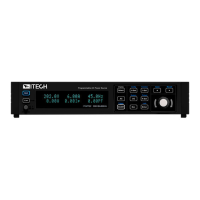Operation and Application
To clear the over-current and return to normal operation, firstly remove the con-
ditions that caused the protection fault. Press [Esc] key (or send the command
PROTect:CLEar) to clear the protection status. The “OCPpeak Occurred!!” dis-
played in front panel is cleared and the instrument exits OCP status.
4.10.6 Set the Over-Power Protection
The user can set the over-power protection point for the over-power protection
function. When the output power reaches the over-power protection point, the
over-power protection will turn off the output. The function is mainly used to pro-
tect the DUT connected during test to prevent it from damage due to over-cur-
rent. The OPP function is always enabled.
Set the OPP point
1. Press the composite keys [Shift] + [F-set](Protect) to enter Protect menu
interface.
2. Rotate the knob to select OPP and press [Enter] key to confirm.
3. Rotate the knob to adjust the OPP point and press [Enter] key to confirm.
4. Press [Esc] to exit the protection menu setting.
Clear OPP status
When over-power protection occurs, the instrument responds as follows:
• The instrument output is turned off, and other keys (except the [Esc] key)
are locked.
• The buzzer sounds intermittently three times: one long beep and two short
beeps.
• The interface displays “OPP Occurred!!”;
• Status register, the OPP status bit is set to 1.
To clear the over-power and return to normal operation, firstly remove the condi-
tions that caused the protection fault. Press [Esc] key (or send the command
PROTect:CLEar) to clear the protection status. The “OPP Occurred!!” displayed
in front panel is cleared and the instrument exits OPP status.
4.10.7 Set the Current Limiting Protection
The user can set the current limiting point for the current limiting protection func-
tion. If the output current reaches the limiting current protection point, the pro-
tection will be activated. The power supply output current is controlled within the
current limiting value, and the output is stopped after several milliseconds. The
Copyright © Itech Electronic Co., Ltd.
76

